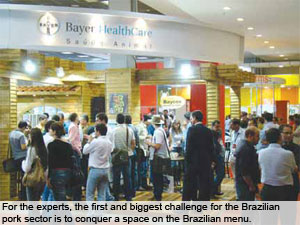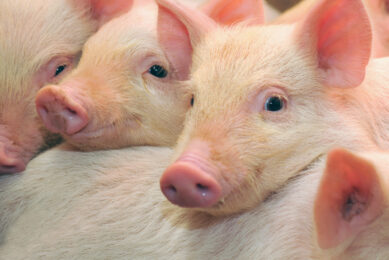Pork Expo 2010: Better marketing the pork story

The importance of the State of Paraná for the Brazilian agribusiness is incontestable. Located in the country’s south, it is the third largest state for pork production and is Brazil’s largest grain barn with a production of 13.3 tonnes of corn. In addition, Brazil’s Pork Expo 2010 also took place here, from 14-17 September.
By Luciana Martins
At its fifth edition, the Pork Expo in Curitiba, gathered 150 companies and 23,000 visitors at the Centro de Convenções Embratel. Approximately 2,200 people attended the conference sections. During the fair, there were cultural and entertainment events, association meetings, technical and scientific seminars, and awards. At the scientific seminars, specialists, scientists and businessmen from over 43 countries gave the recipe for growth of the swine sector in the next ten years. For the experts, the first and biggest challenge for the Brazilian pork sector is to conquer a space on the Brazilian menu. Despite being the world’s number four swine exporter, forecasting a production of 3.3 million tonnes in 2010, domestic per capita consumption is a mere 13.8 kg per year. At the same time, chicken figures are 39.5 kg and beef stands at 34.5 kg.
| Brazil’s best swine producer The software company Agriness awarded the best swine producers. Producer of the ‘S2’ software, that uses several indicators of farm management, have 1,300 programme users, totalling 780,000 sows. “Swine producers send us monthly information. This way, they can compare their own farm performance to other producers and identify where there’s a need for improvement,” said Eduardo Hoff, Agriness spokesman. The best swine producer was Wienfried Leh, from Guarapuava, Paraná, having a number of weaned piglets/ sow/ year of 31.86. “The first positions go through an actual auditing process, carried out by Embrapa’s technicians, in partnership with Associação Brasileira da Indústria Produtora de Carne Suína (Brazilian Swine Producer Association) and Federal University of Rio Grande do Sul,” Hoff said. |
Lack of advertising
Apart from income restrictions, the reason for the pork industry’s backlog is a lack of proper marketing, explained Washington Olivetto, one of Brazil’s key marketing experts. He said, “It is necessary to invest money on lasting and creative advertising campaigns to show the benefits of pork protein.”
The show aimed to provide the recipe for success. On one hand, exhibitors introduced the concept of ‘genetics a la carte’, allowing to focus on specific markets and the production of lean meat, with high nutritional value and longer shelf-life. Others also launched high performance technologies, promising to lower production costs, while keeping the quality.
To increase sow productivity, performance and piglet health, animal nutrition company Novus elaborated on nutritional programmes associated with the use of microminerals, organic supplements and gastrointestinal modulating substances. For more information on this programme, please turn to Pig Progress, volume 26.08. Additional innovations are below.
| Innovations at Pork Expo, Curitiba, Brazil, September 2010 Low FCR, high ADG Dam & sire lines Profitability simulator Virus identifier |











